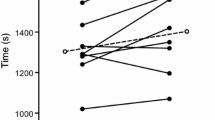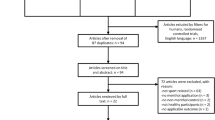Abstract
Menthol has recently been added to various cooling products that claim to enhance athletic performance. This study assessed the effect of two such solutions during exercise in warm, humid conditions. Twelve participants (22 ± 2.9 years; \( \dot{V}{\text{O}}_{{2{\text{peak}}}} \) 47.4 ± 6.2 mL kg−1 min−1) completed a peak power (POpeak) test and three separate exercise bouts in 30°C and 70% relative humidity after being sprayed with 100 mL of water containing either 0.05 or 0.2% l-menthol, or a control spray. During each trial, participants underwent 15 min of rest, spraying, 15 min of rest and 45 min of exercise at 45% of POpeak. The following variables were measured: rectal temperature (T re), sweat rate (SR), skin blood flow (SBF), heart rate (HR), thermal comfort (TC) and sensation (TS) votes, irritation (IRR) and rating of perceived exertion (RPE). Mean skin (MST) and body temperatures (\( \bar{T}_{\text{body}} \)) were calculated. There was no significant difference in MST, \( \bar{T}_{\text{body}} \) SR, SBF, HR, TC or RPE between conditions. Spraying with 0.2% menthol significantly (P < 0.05) elevated T re by 0.2°C compared to the other conditions. Both menthol sprays caused participants to feel significantly cooler than control spraying (P = 0.001), but 0.2% spraying induced significantly cooler sensations (P = 0.01) than 0.05% spraying. Both menthol sprays induced greater irritation (P < 0.001) than control spraying. These findings suggest that 0.05% menthol spraying induced cooler upper body sensations without measurable thermoregulatory impairment. T re was significantly elevated with 0.2% spraying. Irritation persisted with both menthol sprays while TC remained unchanged, suggesting a causal relationship. The use in sport of a spray similar to those tested here remains equivocal.






Similar content being viewed by others
References
Borg GAV (1982) Psychophysical basis of physical exertion. Med Sci Sports Exerc 14:377–381
Cheuvront SN, Montain SJ, Goodman DA, Blanchard L, Sawka MN (2007) Evaluation of the limits to accurate sweat loss production during prolonged exercise. Eur J Appl Physiol 101:215–224
Cliff MA, Green BG (1994) Sensory irritation and coolness produced by menthol: evidence for selective desensitization of irritation. Physiol Behav 56:1021–1029
Colin J, Timbal J, Houdas Y, Boutelier C, Guieu JD (1971) Computation of mean body temperature from rectal and skin temperatures. J Appl Physiol 31(3):484–489
Douglas CG (1911) A method for determining the total respiratory exchange in man. J Physiol 42(s):xvii–xviii
Eccles R (1994) Menthol and related cooling compounds. J Pharm Pharmacol 46:618–630
Eccles R, Griffiths DH, Newton CG, Tolley NS (1988) The effect of d and l isomers of menthol upon nasal sensation of airflow. J Laryngol Otol 102:506–508
Gillis DJ, Barwood M, Tipton MJ (2009) The effect of l-menthol on thermoregulation and sensation during exercise in warm and humid conditions. In: Proceedings from the 13th international conference of environmental ergonomics (ICEE), Boston, USA. The University of Wollongong, AUS, pp 400–404, 2–7 August 2009
Gonzalez-Alonso J, Teller C, Andersen SL, Jensen FB, Hyldig T, Nielsen B (1999) Influence of body temperature on the development of fatigue during prolonged exercise in the heat. J Appl Physiol 86:1032–1039
Green BG (1986) Menthol inhibits the perception of warmth. Physiol Behav 38:833–838
Green BG (1992) The sensory effects of l-menthol on human skin. Somatosens Mot Res 9:235–244
Green BG, Schoen KL (2007) Thermal and nociceptive sensations from menthol and their suppression by dynamic contact. Behav Brain Res 176:284–291
Green BG, Shaffer GS, Gilmore MM (1993) Derivation and evaluation of a semantic scale of oral sensation magnitude with apparent ratio properties. Chem Senses 18(6):683–702
Hale T (2003) Exercise physiology: a thematic approach. Wiley, West Sussex, England, UK
Hong CZ, Shellock FG (1991) Effects of a topically applied counterirritant (eucalyptamint) on cutaneous blood flow and on skin and muscle temperatures: a placebo-controlled study. Am J Phys Med Rehabil 70(1):29–33
Johnson CD, Melanaphy D, Purse A, Stokesberry SA, Dicksjon P, Zholos A (2009) Transient receptor potential melastatin 8 channel involvement in the regulation of vascular tone. Am J Physiol Heart Circ Physiol 296:H1868–H1877
Jort SE, McKemy D, Julius D (2003) Lessons from peppers and peppermint: the molecular logic of thermosensation. Curr Opin Neurobiol 13:487–492
Kounalakis SN, Botonis PG, Koskolou MD, Geladas ND (2010) The effect of menthol application to the skin on sweating rate response during exercise in swimmers and controls. Eur J Appl Physiol. doi:10.1007/s00421-009-1345-6)
Kozyreva TV, Tkachenko EY (2008) Effect of menthol on human temperature sensitivity. Human Physiol 34(2):221–225
Martin D, Valdez J, Boren J, Mayersohn M (2004) Dermal absorption of camphor, menthol and methyl salicylate in humans. J Clin Pharmacol 44:1151–1157
McKemy DD, Neuhausser WM, Julius D (2002) Identification of a cold receptor reveals a general role for TRP channels in thermosensation. Nature 416:52–58
Olesen BW (1984) How many sites are necessary to estimate a mean skin temperature? In: Hales JRS (ed) Thermal physiology. Raven Press, New York
Peier AM, Moqrich A, Hergarden AC, Reeve AJ, Andersson DA, Story GM, Earley TJ, Dragoni L, McIntyre PZ, Bevan S, Patapoutian A (2002) A TRP channel that senses cold stimuli and menthol. Cell 108:705–715
Schafer K, Braun HA, Isenberg C (1986) Effect of menthol on cold receptor activity. J Gen Physiol 88:757–776
Sessler DI, Sessler AM, Hudson S, Moayeri A (1993) Heat loss during surgical skin preparation. Anaesthesiology 78:1055–1064
Tajino K, Matsumura K, Kosada K, Shibakusa T, Inoue K, Fushiki T, Hosokawa J, Kobayashi S (2007) Application of menthol to the skin of whole trunk in mice induces autonomic and behavioral heat-gain. Am J Physiol Regul Integr Comp Physiol 293:R2128–R2135
Wasner G, Schattschneider J, Binder A, Baron R (2004) Topical menthol: a human model for cold pain by activation and sensitization of C nociceptors. Brain 127:1159–1171
Yosipovitch G, Szolar C, Hui XY, Maibach H (1996) Effect of topically applied menthol on thermal, pain and itch sensations and biophysical properties of the skin. Arch Dermatol Res 288:245–248
Zhang H (2003) Human thermal sensation and comfort in transient and non-uniform thermal environments. PhD thesis, University of California, Berkley, CA, USA
Acknowledgments
The authors would like to thank the participants who volunteered for this study. This investigation would not have been possible without technical assistance from Nicola Ferguson. This work was supported by Dr. Scott Drawer and Dr. Nikolai Boehlke and received funding from the Research and Innovation Team at UK Sport.
Author information
Authors and Affiliations
Corresponding author
Additional information
Communicated by George Havenith.
Rights and permissions
About this article
Cite this article
Gillis, D.J., House, J.R. & Tipton, M.J. The influence of menthol on thermoregulation and perception during exercise in warm, humid conditions. Eur J Appl Physiol 110, 609–618 (2010). https://doi.org/10.1007/s00421-010-1533-4
Accepted:
Published:
Issue Date:
DOI: https://doi.org/10.1007/s00421-010-1533-4




